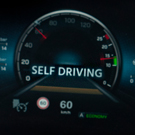Insights
 New Challenges for Transportation Insurers
New Challenges for Transportation Insurers
June 1, 2023
Although the technology is relatively new, electric and autonomous vehicles are already significantly transforming the transportation landscape, with profound implications for the insurance industry. The shift towards these advanced vehicle technologies is introducing both challenges and opportunities for insurers.
In this article, we explore both the challenges and potential opportunities presented by emerging transportation technologies.
To learn more about transportation insurance solutions, visit our Transportation page.
Shifting Costs, Shifting Risks
Electric vehicles, commonly referred to as EVs, contribute to environmental sustainability but often come with higher upfront costs than their conventional counterparts. These upfront costs have the negative impact of making EVs more expensive to replace or repair, potentially increasing insurance premiums.
By contrast, the longer-term operational costs of electric vehicles may be lower due to fewer moving parts and lower fuel expenses, which could influence insurance calculations in ways unforeseen by the insurance industry. As the vehicle technology matures, the impacts upfront and long-term expenses will become clearer, helping to stabilize insurance underwriting.
Autonomous vehicles bring about a paradigm shift in the notion of liability. With the introduction of self-driving technology, the responsibility for accidents can and has shifted from the driver to the manufacturer or the software provider. In fully autonomous vehicles, where there’s no human intervention in the driving process, if an accident occurs, it could be due to a flaw or malfunction in the software or hardware that controls the vehicle, rather than human error. In this scenario, the liability could shift from the driver to the manufacturer or software provider responsible for the autonomous system. This represents a significant shift in liability from individuals to corporations.
Of course, this doesn’t mean that driver liability will disappear entirely. In semi-autonomous vehicles, where the driver is expected to take control in certain situations, liability might be shared between the driver and the manufacturer or software provider, depending on the specifics of the accident. These shifts in liability raises complex legal and regulatory questions, which are still being debated and will likely take time to fully resolve. These include questions about how to determine fault when a self-driving car crashes, what standards to apply to autonomous vehicle technologies, and how to regulate and insure these vehicles to protect consumers and the public.
Emerging Opportunities for Insurers
Electric and autonomous vehicles are data-rich environments, collecting a wide array of information through a host of sensors and onboard systems. Here are some of the main types of data these vehicles collect:
- Telemetry Data: This includes information about the vehicle’s speed, acceleration, braking, steering, and more. In autonomous vehicles, this might also include data about when and how the autonomous systems were engaged and disengaged.
- Location Data: GPS systems in these vehicles record data about the vehicle’s location and the routes it has taken.
- Vehicle Status Data: This includes data about the vehicle’s systems and their performance, such as tire pressure, oil levels, engine performance, and any diagnostic trouble codes.
- Sensor Data: Autonomous vehicles, in particular, collect massive amounts of data from sensors like LIDAR, radar, cameras, and ultrasonic sensors. This data is used to perceive the vehicle’s surroundings and make driving decisions.
- Driver Behavior Data: Some vehicles collect data about the driver’s behavior, including driving style (e.g., aggressive or defensive), seatbelt use, use of infotainment systems while driving, etc.
- Occupancy Data: Data such as the number of passengers, their weight (for airbag deployment adjustment), and seat occupation.
- Environmental Data: This includes data about weather conditions, road conditions, temperature, etc., which can impact vehicle performance and driving decisions in autonomous vehicles.
Data collected from electric and autonomous vehicle operations can significantly enhance insurance underwriting. Driving behavior data and GPS information help insurers understand risk profiles better, potentially adjusting premiums accordingly. Data on vehicle status and battery usage can indicate the vehicle’s maintenance level, affecting risk assessment. For autonomous vehicles, the usage of autonomous systems can also influence underwriting. Moreover, predictive analytics using these data points allows for more accurate policy pricing, while post-accident data aids in efficient claims processing.
Leveraging this data will eventually lead to new opportunities for insurers, allowing them to develop more personalized insurance products and more accurate risk assessments. Challenges surrounding data privacy, consent, and security must be worked out, however. Regulators, insurers, and vehicle manufacturers will need to work together to address these challenges and create a framework that protects consumers’ rights while allowing for innovation in insurance underwriting. ◼

